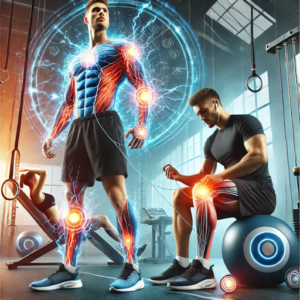Unlocking Muscle Recovery Through Electrotherapy
Electrotherapy for muscle revitalisation is an innovative therapeutic method that uses electrical energy to stimulate the body’s tissues. It plays a key role in physical rehabilitation and wellness today. Far from being a modern-day trend, this method has deep historical roots, with evidence of electrical phenomena being used for healing in ancient civilisations. Today, electrotherapy encompasses a variety of techniques, including transcutaneous electrical nerve stimulation (TENS), neuromuscular electrical stimulation (NMES), and interferential current therapy, each designed to address specific health concerns.
A growing understanding of human physiology and pain management has driven the evolution of electrotherapy. This progress has cemented electrotherapy as a pivotal component of modern therapeutic practices. Its resurgence in popularity can be attributed to its non-invasive nature and the mounting evidence supporting its effectiveness. As more individuals seek non-medicinal options for managing pain, electrotherapy stands out as an appealing solution, offering relief for muscle pain, enhancing recovery from injuries, and improving overall physical well-being.
The appeal lies in its capacity to alleviate discomfort and its potential to enhance muscle function and promote healing. As we explore the mechanisms behind electrotherapy, it becomes clear that this versatile approach holds numerous benefits for individuals looking to optimise their physical health and wellness.
Key Insights into Electrotherapy
- Electrotherapy is a treatment that uses electrical energy to activate muscle tissue, supporting healing and recovery.
- It sends electrical impulses to targeted body areas, helping reduce pain, boost muscle strength, and improve blood circulation.
- Electrotherapy offers advantages such as pain relief, muscle relaxation, increased range of motion, and faster tissue healing.
- A range of electrotherapy devices, such as TENS units, EMS devices, and ultrasound machines, are available, each offering unique benefits depending on its application.
- When using electrotherapy devices, it’s essential to follow the manufacturer’s instructions and consult a healthcare professional if you have any concerns or underlying health conditions.
 Understanding Electrotherapy: How It Heals and Restores
Understanding Electrotherapy: How It Heals and Restores
Electrotherapy applies electrical currents to the body via electrodes placed on the skin, triggering various physiological responses. These electrical impulses interact with nerve fibres and muscle tissues, resulting in therapeutic effects. For instance, TENS therapy delivers low-voltage signals that block pain signals from reaching the brain, relieving chronic pain conditions.
This process is similar to the body’s natural pain-relief mechanism, encouraging the release of endorphins—natural painkillers that reduce pain perception. Neuromuscular electrical stimulation (NMES) takes this further by directly targeting muscle fibres. NMES stimulates motor neurons, causing muscles to contract, which aids in strengthening muscles and is an integral part of rehabilitation following injury or surgery.
This combination of pain relief and muscle activation showcases the diverse potential of electrotherapy as a treatment. As research continues to uncover the intricate effects of electrical stimulation on cellular processes and tissue repair, electrotherapy is increasingly seen as a long-term solution for muscle recovery and rejuvenation.
Top Benefits of Electrotherapy for Muscle Healing
Electrotherapy offers many benefits, making it a popular choice for athletes, individuals recovering from injuries, and those looking to improve their physical performance. One key advantage is its ability to accelerate recovery from muscle injuries. Electrotherapy can speed up the healing process of muscle strains and tears by stimulating blood flow and reducing inflammation.
This treatment is particularly beneficial for athletes returning to their sport after injury, as it helps them regain strength and functionality faster than traditional rehabilitation methods alone. Electrotherapy is also effective in building muscle strength and endurance. Regular use of NMES devices can lead to increased muscle mass and improved neuromuscular coordination, both critical for peak physical performance.
In addition to aiding injury recovery, electrotherapy can be an excellent option for individuals who have difficulty engaging in traditional exercise due to pain or mobility issues. By stimulating muscle activity without the need for strenuous physical exertion, electrotherapy helps maintain muscle mass and prevent muscle atrophy, making it an invaluable tool for those with limited mobility.
 Exploring the Different Electrotherapy Devices
Exploring the Different Electrotherapy Devices
Electrotherapy devices vary widely in their design and applications, allowing them to meet diverse therapeutic needs. The TENS unit is one of the most commonly used devices for pain management. These portable devices are often equipped with multiple settings, enabling users to adjust the intensity and frequency of electrical impulses according to their comfort levels.
TENS units are ideal for home use, offering individuals a convenient way to manage chronic pain conditions like arthritis or lower back pain without relying solely on medication. In contrast, NMES devices are specifically designed for muscle stimulation and rehabilitation. These units range from simple, handheld devices to advanced systems used in clinical settings.
Many NMES devices have programmable settings that allow healthcare providers to tailor treatment protocols to each patient’s specific needs. Additionally, hybrid devices that combine the capabilities of TENS and NMES offer a comprehensive solution for pain relief and muscle recovery. As technology evolves, we can expect more sophisticated electrotherapy devices that further enhance user experience and therapeutic outcomes.
Using Electrotherapy for Maximum Muscle Recovery
When incorporating electrotherapy into your muscle recovery routine, a strategic approach is necessary to achieve the best results and minimise discomfort. Consulting a healthcare professional or physiotherapist before starting an electrotherapy regimen is essential. They can guide you in selecting the right device for your needs and help develop a personalised treatment plan.
After selecting a device, familiarising yourself with its functionality is crucial. Most electrotherapy units come with user manuals that provide instructions on placing electrodes correctly and adjusting settings for optimal results. Proper electrode placement ensures that electrical impulses target the intended muscles and nerve fibres effectively.
It’s advisable to start with lower-intensity settings and gradually increase them as you become more comfortable. Sessions typically last 20 to 30 minutes, though the duration can be adjusted based on individual tolerance and treatment goals. Consistency is vital to reaping the benefits of electrotherapy—incorporating it into your routine several times a week can significantly improve muscle strength and recovery.
Monitoring your progress and adjusting your treatment plan as necessary will help you optimise the therapeutic effects of electrotherapy, making it a powerful tool in your muscle recovery journey.
 Essential Safety Precautions for Electrotherapy
Essential Safety Precautions for Electrotherapy
While electrotherapy is generally safe, certain precautions must be taken to ensure its safe and effective use. Individuals with pre-existing medical conditions such as epilepsy or heart disease or those with implanted devices like pacemakers should avoid using electrotherapy without consulting a healthcare professional. The electrical impulses could interfere with these devices or conditions, potentially causing serious complications.
Pregnant women should also seek medical advice before using electrotherapy, as its effects during pregnancy have not been thoroughly studied. Another important consideration is skin sensitivity. Some individuals may experience irritation or allergic reactions at the electrode sites. To minimise the risk of irritation, use hypoallergenic electrodes and ensure the skin is clean and dry before applying them.
Additionally, it’s essential to avoid placing electrodes on areas with broken skin, rashes, or wounds, as this could lead to further irritation or infection. Paying attention to your body during treatment is key—if you experience discomfort or any unusual reactions, you should stop using the device and consult a healthcare provider. By following these guidelines, you can safely enjoy the benefits of electrotherapy.
Making Electrotherapy a Part of Your Muscle Recovery Routine
Integrating electrotherapy into your routine can significantly enhance muscle recovery and overall physical performance. Whether you’re an athlete, recovering from surgery, or dealing with chronic pain, electrotherapy offers an effective, non-invasive option for improving muscle function and speeding up recovery.
Incorporating electrotherapy into a well-rounded recovery plan that includes traditional rehabilitation methods like physiotherapy and massage can provide a comprehensive approach to healing. Electrotherapy can help you reach your fitness and recovery goals more effectively by reducing pain, improving circulation, and promoting muscle activation.
To maximise its benefits, follow best practices, seek guidance from healthcare professionals, and maintain consistency in your electrotherapy sessions. As the science behind electrotherapy advances, this therapy is poised to play an even greater role in muscle recovery and physical wellness. Electrotherapy is not just a temporary fix—it’s a long-term solution for those committed to improving their health and vitality.
Electrotherapy is a promising tool for muscle recovery, but it can also be complemented by other therapies for even better results. One such therapy is cupping, which has gained popularity for improving circulation and relieving muscle tension. To explore how cupping can work alongside electrotherapy, you might enjoy reading “Cupping Therapies: Unveiling the Mysteries.”
Frequently Asked Questions About Electrotherapy
What is electrotherapy for muscles?
Electrotherapy is a technique that uses electrical stimulation to relieve pain, improve muscle strength, and accelerate the healing process.
How does electrotherapy work?
Electrotherapy sends electrical impulses through the skin to the muscles, relieving pain, improving circulation, and inducing muscle contractions.
What are the benefits of electrotherapy for muscles?
Electrotherapy can reduce pain, increase muscle strength and endurance, improve mobility, and speed up recovery from muscle injuries.
Are there any risks associated with muscle electrotherapy?
Electrotherapy is safe when performed correctly by trained professionals. However, following healthcare guidelines is important to minimise any potential risks.
Who can benefit from electrotherapy?
Electrotherapy can help those experiencing muscle pain, weakness, or injury. It’s also useful for rehabilitation after surgery or injury.
What are the possible side effects of electrotherapy?
Electrotherapy is not recommended for pregnant women, individuals with pacemakers or other implanted devices, or those with certain skin conditions. If you have concerns, consult with a healthcare provider before using electrotherapy.
Brought to you by: Electrotherapy Preston
The Article: Muscle Revitalisation with Electrotherapy appeared first on https://mcrtherapies.co.uk
The Article Muscle Revitalisation with Electrotherapy appeared first on https://mcrtherapies.com
The Article Muscle Revitalisation with Electrotherapy Was Found On https://limitsofstrategy.com


This post brings to light a fascinating aspect of muscle recovery that doesn’t get enough attention in conventional wellness discussions. The historical context you touched on is particularly striking—it’s intriguing to think that ancient civilizations recognized the benefits of electrical phenomena for healing long before modern science validated these practices.
You raise an interesting point about how historical practices often get overshadowed by modern science, yet they sometimes offer valuable insights into what we now consider advanced healing techniques. It’s fascinating to think about how ancient civilizations, perhaps without the knowledge we have today, were able to harness something as complex as electrical phenomena for recovery.
You’ve hit on something really interesting there. It’s amazing how ancient cultures seemed to have a deep intuition about the body’s healing processes, often using methods that science is now starting to understand more fully. For instance, the use of electrical phenomena in healing isn’t just a modern invention; we see it in historical practices like the use of shock from electric fish in ancient remedies. It’s such a testament to how human beings have always sought ways to enhance wellbeing.
You’ve brought up such a fascinating point about the intersection of ancient wisdom and modern scientific understanding. It’s intriguing to think about how our ancestors utilized natural resources around them for healing—often in ways we’re just starting to validate with contemporary research. The use of electric fish, like the torpedo fish, is such a unique example; their ability to produce electric shocks for defense and hunting was cleverly repurposed for pain relief and other ailments.
It’s really interesting to explore how much wisdom our ancestors contained within their understanding of nature. They had this incredible ability to observe their surroundings and harness the natural world in ways that, in many cases, were inherently profound. The electric fish, like the torpedo fish, serves as a great example of this. The dual purpose of their electric shocks—used for both defense and hunting—shows a cleverness that was not only about survival but also about adapting to the environment creatively.
You make a really good point about how ancient civilizations seemed to have a sense of the healing properties of electrical phenomena long before we had the science to back it up. It’s wild to think about how they might have stumbled upon it, right? There’s something almost poetic about the blend of ancient wisdom and modern science.
You bring up a fascinating point. It’s intriguing to think about how ancient people might have interacted with the natural world, noticing things we often overlook today. They probably didn’t have the scientific foundation we have now, but they seemed to have their own ways of understanding health and energy.
You bring up a great point about the wisdom of ancient civilizations. It’s fascinating to consider how they intuitively grasped the healing properties of electrical phenomena, often in ways that align surprisingly well with what we’re discovering today.
The historical roots of electrotherapy are indeed fascinating, and it’s interesting to see how ancient practices have evolved into a sophisticated therapeutic approach today. However, I wonder about the accessibility of these technologies, especially for those who may not have access to modern healthcare facilities. With various forms of electrotherapy becoming more popular, will there be a push to create at-home devices that are safe and effective for the average person?